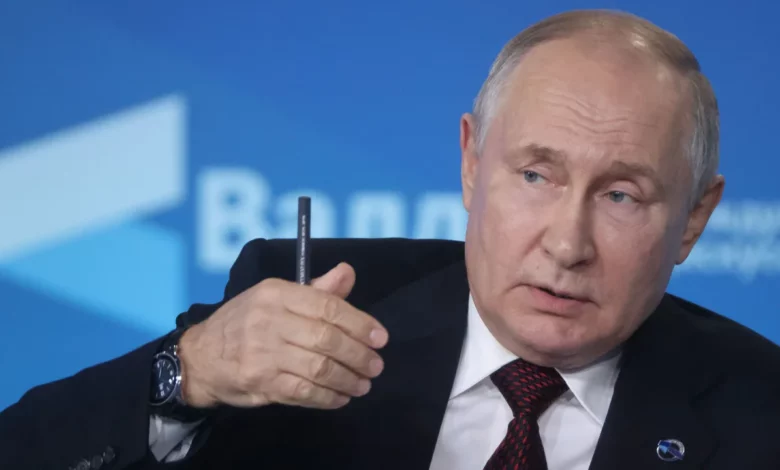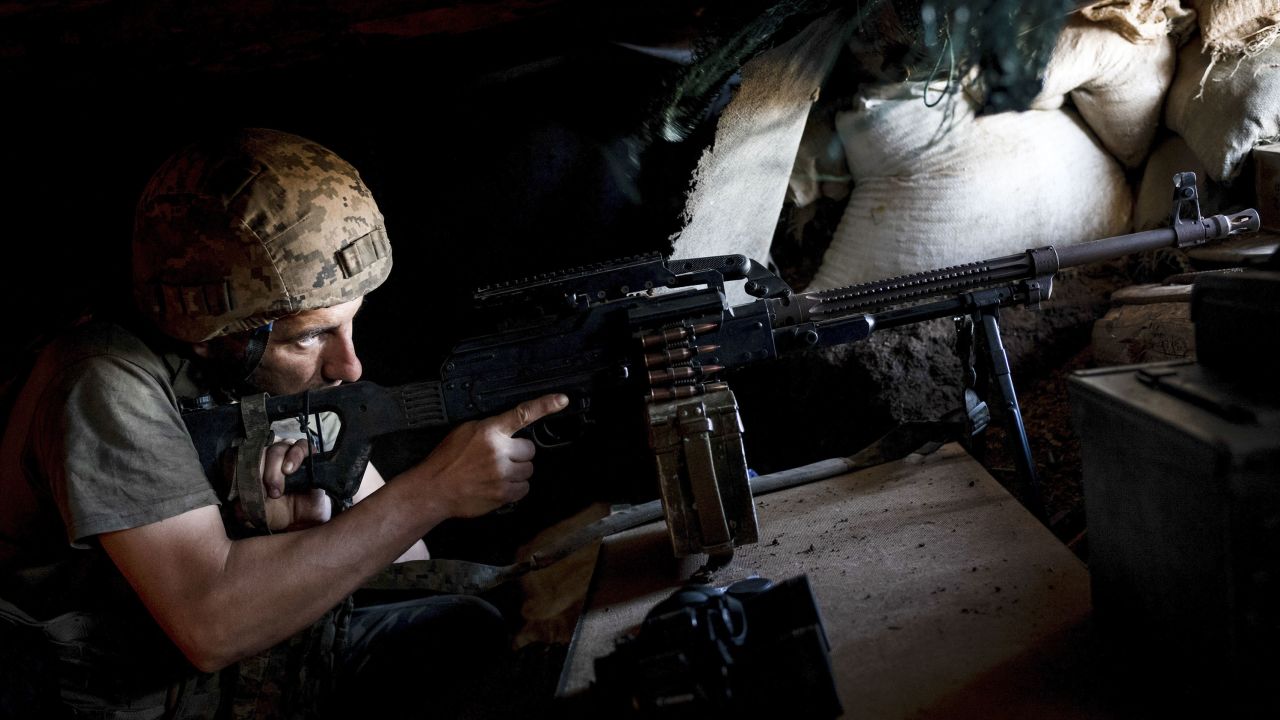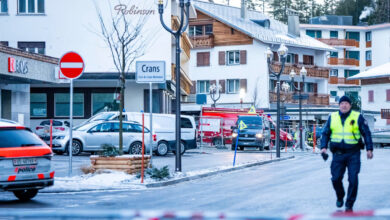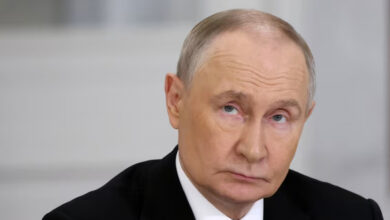
Russian President Vladimir Putin is making a slightly less ambitious forecast: If things go his way, the war can be over in a week.
In remarks Thursday at the annual meeting of the Valdai Discussion Club, a Kremlin-friendly confab on global issues, Putin predicted that Ukraine would collapse if the West turns off the taps of military aid and economic assistance.
“By and large, the Ukrainian economy cannot exist without external support,” he said. “Once you stop this, everything will be over in a week. Finished. The same applies to the defense system: Imagine that supplies will stop tomorrow — you will only have a week to live when the ammunition runs out.”
These remarks were perhaps Putin’s most clear articulation to date his strategy in Ukraine: He is counting on the Western alliance that backs Ukraine to fracture, the longer the gruesome war of attrition grinds on. And developments in recent days, to the alarm of Ukraine’s supporters, suggest that Putin’s plan may be gaining some traction.
Take the recent headlines from Washington. Last week, President Joe Biden signed into law a stopgap bill to avert a government shutdown, but funding for Ukraine was a casualty of the brinksmanship on Capitol Hill.
The measure signed into law may keep the US government open only through November 17, but it includes no additional funding for Ukraine.
The Biden administration emphasizes that that the American public’s support for Ukraine remains strong. But the lack of funding in the bill for Ukraine sets the clock ticking for Kyiv, and has the White House scrambling for workarounds.
Throughout the war, the US has been a steady lifeline for Ukraine, committing a total of around $113 billion to it, including direct military assistance, budget infusions and humanitarian assistance.
But the ouster of House Speaker Kevin McCarthy has thrown the short-term prospects for a new assistance package into serious doubt: Without a permanent speaker, legislative business in the House is effectively on hold.

The administration does have some options. The Pentagon Comptroller — the Department of Defense’s chief financial officer — has noted that there is the option to replenish Ukraine’s dwindling military supplies through what is known as Presidential Drawdown Authority.
But to the drama in Congress add: resistance among far-right Republican legislators raises serious questions about the US sustaining aid longer term for Ukraine, particularly during a major counteroffensive.
And then there is the race for the Republican presidential nomination, which likely also plays into Putin’s calculus. The Kremlin is no doubt mindful of the fact that several GOP aspirants are vocal skeptics when it comes to aiding Ukraine. Trump, no friend to Ukraine, is leading the pack.
The United States, it’s worth remembering, is not the only country shouldering the financial burden of supporting Ukraine. European Union members provide around 39 percent of direct military assistance to Ukraine.
Putin is clearly counting on Ukraine fatigue in Europe. Earlier this week, a party headed by Robert Fico, a populist, pro-Kremlin figure, came out on top in parliamentary elections in Slovakia, an EU and NATO member. Fico has called on the Slovak government to stop arming Ukraine, and his bogus rhetoric — blaming “Ukrainian Nazis and fascists” for provoking Russia’s full-scale invasion of Ukraine — must no doubt be music to Putin’s ears.
Putin’s advisors also appear to be reading the defense trade press. In his remarks this week, the Kremlin leader noted that the US industrial base is struggling to ramp up demand for ammunition for Ukraine, which has been locked in an artillery slogging match with Russia.
“The United States produces 14 thousand 155-mm shells, and Ukrainian troops expend up to five thousand per day, and there they produce 14 [thousand] per month,” he claimed at the Valdai conference. “Do you understand what we’re talking about? Yes, they are trying to increase production – up to 75,000 by the end of next year, but we still have to wait until the end of next year.”
Putin’s notecards may have been slightly off – US monthly production is currently at 28,000 shells. But the Russian president was not mischaracterizing the fact that the US and its European allies are locked in a desperate race against Russia’s industrial base.

In a discussion this past week at the Warsaw Security Forum, Royal Netherlands Navy Adm. Rob Bauer, chair of the NATO Military Committee warned that “the bottom of the barrel is now visible” when it comes to ammunition production for Ukraine.
Putin, then, appears to be counting on both dysfunction in Washington and stress within the transatlantic alliance for his strategy of attrition to work. That strategy, to some degree, also depends on winning a battle of perception. If Ukraine is seen as a losing cause, Kremlin logic argues, then its patrons will pull the plug.
But what about the actual situation on the ground in Ukraine, as winter draws near and a much-anticipated Ukrainian counteroffensive makes only incremental gains? Is the situation as dire as Putin might suggest?
Putin casts that fight in existential terms, arguing this week that nothing less than a twilight struggle is underway to establish a new world order congenial to authoritarian states — and implying that Russia is in this for the long haul.
“The Ukrainian crisis is not a territorial conflict, I want to emphasize this,” he said at the Valdai forum. “Russia is the largest country in the world, with the largest territory. We have no interests in terms of conquering any additional territories. We still have to explore and develop Siberia, Eastern Siberia and the Far East. This is not a territorial conflict or even the establishment of a regional geopolitical balance. The question is much broader and more fundamental: we are talking about the principles on which the new world order will be based.”
Leave aside for a moment that Putin has, at other times, brazenly framed the invasion of Ukraine as project of imperial restoration. In his remarks at Valdai, he clearly implied that Russia intends to outlast the West over Ukraine.
But not everyone, and especially not Ukrainians, believe it’s a waiting game.
Tymofiy Mylovanov, the president of the Kyiv School of Economics, responded to Putin’s Valdai remarks with a reminder that Ukrainians would still fight for survival regardless of Moscow’s goal of hiving off support for his country.
Paraphrasing Putin, Mylovanov said that the Kremlin believes that “Ukraine will have one week left to LIVE once Western supplies are over. LIVE as in EXIST, not defend or resist.
What defending or resisting comes is down not just to action on Capitol Hill. Putin’s credibility has been dented in recent months by the Wagner mutiny, as well as the Russian government’s ability to muster motivated, well-trained troops after a sustained hammering on the battlefield.
If Putin is counting on a long war to blunt Western will to support Ukraine, he is also taking a gamble on the longevity of his system of rule — and perhaps underestimating the resolve of Ukrainians, whom he sees as merely a puppet of Washington and Brussels.
And that is where the dark headlines for Ukraine have the unsurprising result of hardening Ukrainian resolve. Whether the deadly strike on the village of Hroza or Friday’s attack on Kharkiv, Ukraine’s will to fight, regardless of US and Western support, appears unwavering.




